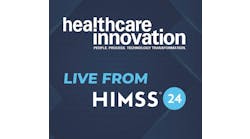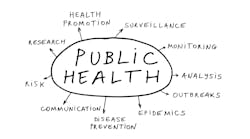In 2018, the Centers for Disease Control and Prevention (CDC) funded the National Association of Chronic Disease Directors (NACDD) to pilot a surveillance project using EHR data modeled after an earlier project in Massachusetts. During the recent SHIEC conference, public health officials from Washington State described their experience piloting MENDS (Multi-state EHR-based Network for Disease Surveillance).
Partners piloting the MENDS project include Washington’s OneHealthPort HIE and the State Department of Health, REACHnet (Louisiana Public Health Institute), AllianceChicago, and the Regenstrief Institute in Indiana.
Jessica Marcinkevage, Ph.D., M.S.P.H., is the team lead for the Chronic Disease Assessment Team and epidemiologist for the Healthy Eating Active Living and Fruit and Vegetable Incentive Programs at the Washington State Department of Health. She said that traditionally, public health agencies collect healthcare system data on communicable diseases from fax messages or HL7 messages through the HIE. They conduct phone or electronic surveys like the state’s Behavioral Risk Factor Surveillance System or BRFSS. These traditional systems take a lot of time to collect, process and release data, and do not always lead to the most timely results, she said.
Under this newly developed model of chronic disease surveillance, cases are not reported to public health individually, Marcinkevage said. “Rather, we piggyback on data already collected and stored behind partners’ firewalls and ensure that there are standardized case definitions to be used for public health surveillance, and opportunities for fulfilling ad hoc data requests in a secure fashion.”
National partners, in collaboration with the CDC, sought to create a model that would use EHR-based surveillance. She said it embraces six key principles:
• Leveraging clinical data available in EHRs such as demographics, vital signs, lab tests, prescriptions and diagnoses;
• Applying transparent and clinically relevant algorithms for surveillance;
• Providing compatibility with an array of EHR systems —not being tied to one proprietary platform but allowing for flexibility;
• Allowing data owners to retain control and oversight of their own data;
• Ideally, using an open source platform; and
• Assuring flexibility for emerging data exchange standards, for example, through FHIR.
Based on earlier work done at the Massachusetts Department of Public Health, MENDS sought states to participate in a pilot project for establishing a national system. Washington was selected and was very involved in establishing the governance structure for the national MENDS program.
Marcinkevage said they have done work to define reliable chronic disease indicators with a focus on conditions such as hypertension, smoking, diabetes, and obesity. The project also includes weighting and modeling exercises and governance for those exercises to offer estimates at the national state, county and ZIP code levels.
As the NACDD website explains, the MENDS pilot uses a gatekeeper model so that only aggregated information is released to health departments.
MENDS leverages an open source platform called Electronic medical record Support for Public health (ESP) to extract, analyze, and transmit data from providers to public health agencies to support data analysis and decision-making. ESP runs in the healthcare provider’s data center and generates secure electronic reports for approved data users. It is designed to be compatible with any EHR system, NACDD says.
Washington has been involved since 2018 with a MENDS pilot for disease surveillance by leveraging the OneHealthPort HIE infrastructure. “The driving force to take part in this pilot was to not only provide public health with timely access to chronic disease surveillance data for policy and program design, but also to leverage the infrastructure to create an analytics platform that can be used by various business partners,” said Jyotsna Rao, M.B.A., senior project manager at OneHealthPort.
The HIE’s clinical data repository aggregates patient-level data on all managed Medicaid clients in state. This aggregated data on managed Medicaid clients is the primary input to the MENDS pilot, Rao said. The healthcare professional records the patient data in their EHR. The data partner, which can be the provider organization, extracts clinical data that is then sent to the ESP software, which puts the data in standardized tables and runs disease detection algorithms nightly.
Amy Sullivan, Ph.D., M.P.H., senior epidemiologist for the Prevention and Community Health Division at the Washington State Department of Health, described some of MENDS’ visualization tools. Clicking on the map takes you to a ZIP code-level display to better understand the distribution of a given condition, such as Type 2 diabetes, across the state. “This allows public health and our partners to better identify and understand which communities are experiencing the greatest burden of disease,” she said.
“The most fundamental case for obtaining consistent cross-jurisdictional public health surveillance information is to understand what is going on with chronic disease conditions across our state, our nation and in our communities,” Sullivan said, adding that it's important to remember the chronic diseases do not typically have direct provider reporting systems. “The surveillance surveys we've relied on for so long have been weakened by changing social responses to phone surveys and pre-COVID underfunding of public health infrastructure. MENDS also brings consistency to chronic disease surveillance by using agreed-upon national case definitions and standardized validation activities.”
The modeling component is also important for looking at sparsely populated areas, Sullivan added. More specific use cases for what to do with this public health surveillance information include addressing health disparities — for example, using the data to assess programs that track cardiovascular health outcomes when preventive health services are improved for at-risk women or identifying geographic areas where it makes the most sense to support diabetes and hypertension prevention partnerships between healthcare systems and community partners. These systems will also allow public health to proactively share information with users ranging from legislators to healthcare systems for planning needs, whether it is for new policies to support constituents, or planning future healthcare operational needs, like where to cite a new clinic, she said.
“Our overall goal is to improve chronic disease surveillance for the population as a whole,” Sullivan said. “At this time in Washington, we are limited to accessing Medicaid data. While this represents a very important and vulnerable part of our population, we are looking for opportunities to involve expanded information gathering from healthcare systems and other providers as a more representative picture of the population.”
For the future, she said, the State of Washington wants to continue as part of this national chronic disease surveillance collaboration. “This participation not only supports national goals, it also supports the work needed in Washington for everything from examples like mapping ICD version updates to creating and testing new algorithms for emerging situations for COVID-19 vaccinations, or fentanyl overdoses,” she said. “Bringing in the FHIR standard will also improve current data exchange processes.”


